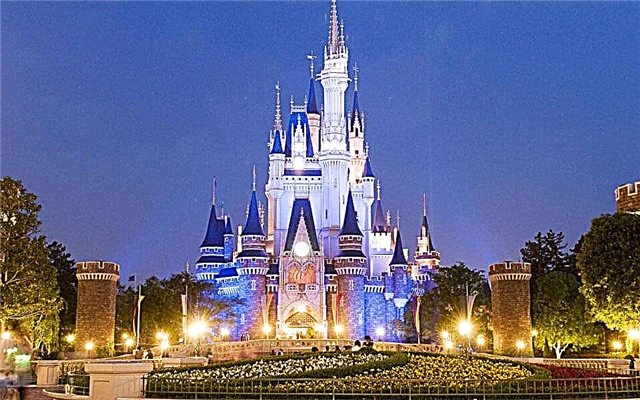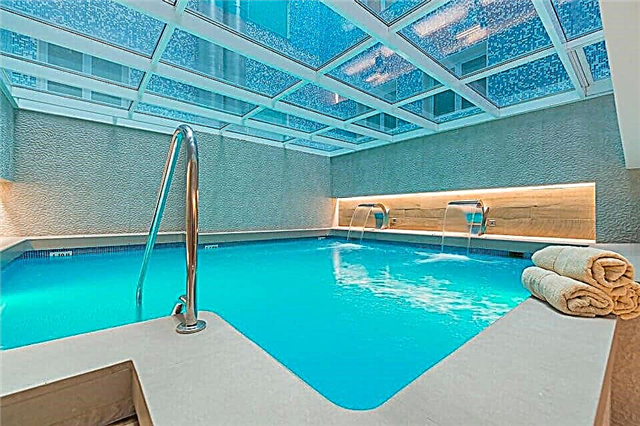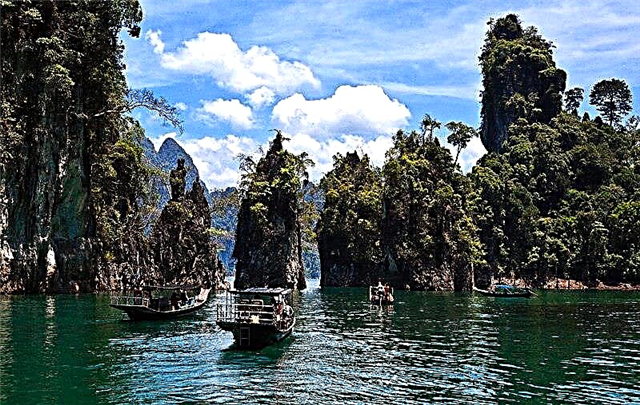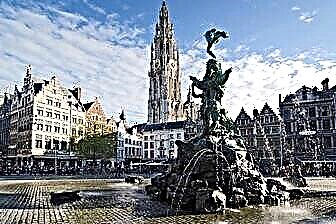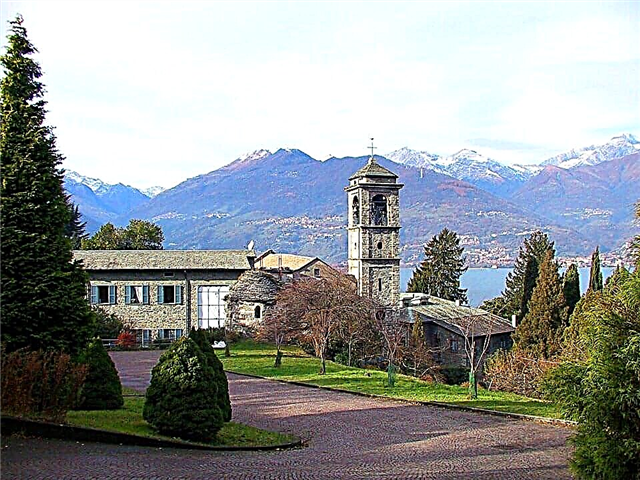Tourists from all over the world come to this wonderful lake. Amazing nature, mild climate and an abundance of historical sites allure. And it has always been that way. Representatives of noble families in Europe lived for a long time in coastal villas. Even Empress Maria Feodorovna Romanova rented one of the estates for 2 whole years. The doctor recommended the mountain-lake climate to her to improve her health. The sights of Como leave no one indifferent: everything here is imbued with the spirit of the Middle Ages.
Baradello castle

Castello Baradello is an ancient building, the exact date is not called by historians. But the tower constantly participated in all significant battles that took place in Italy:
- In a fortress built on a high hill, in the 6th century the local garrison defended itself against the warlike Lombards. The defenders held out for about 20 years.
- In the 12th century, the war between Milan and Como broke out. The Milanese defeated the opponents, burned and plundered the city. But Baradello successfully repulsed all attacks and resisted.
- At the end of the 12th century, the garrison defended itself against the troops of the Lombard League. In 1778, by order of Friedrich Barbarossa, Baradello was additionally fortified and rebuilt. It is the towers of this fortress that tourists see today.
- In the 13th century, the cellars of Baradello became a prison for the losers of the next Della Torre war. And the victorious Visconti once again rebuilt the castle.
- In the 16th century, Baradello was again at the center of events. During the war between France and the Holy Roman Empire, it was ordered to be destroyed so that the French army would not use excellent fortifications. Fortunately, there are a few towers left.
The owners of Baradello also changed. First, the castle belonged to the city, then to the Roman Catholic Church, then again to the city. Today, tourists willingly visit the picturesque hilltop location. But it is important to remember: the guests enter the fortress in organized groups of at least 10 people.
Villa Olmo

The first owner of the palace was the Marquis of Odescalchi. It was he who named the estate Olmo because of the elm tree planted by Pliny the Younger. The construction of the mansion took about 20 years. The result is a very modest building on the outside and richly decorated on the inside. When designing, the architect adhered to the traditions of neoclassicism, but the interiors were created by the famous Fontana. Its frescoes are perfectly preserved, and the stucco and gilding were renewed during the restoration.
In general, the park of the villa attracts tourists even more than the building itself. A small home temple was built in it, a man-made stream flows. And at the very house, guests are greeted by an unusual fountain: small children lively play with the sea monster. The park is very clean and well-groomed, one of the alleys goes down to the picturesque lake. It is nice to walk here and take a break from the heat of the day. At different times, Napoleon Bonaparte, the Queen of Sardinia, Sicily, Giuseppe Garibaldi visited Olmo. This adds charm to the villa.
Duomo Cathedral

This temple is famous not only in Como, but also in Lombardy. No wonder: it was built for almost 4 centuries. The result is a building unlike anything else, combining Gothic and Baroque features. True, historians believe: some details do not harmonize at all with each other. The baroque dome looks ugly next to the gothic walls, the sculptures stand out from the general picture.
Before the start of work, a small church of Santa Maria Maggiore stood on this site. It fell into disrepair, ceased to accommodate all parishioners, and it was decided to build a grandiose cathedral. The Duomo Temple in Milan was chosen as a model. The structure turned out to be grandiose: 87x56x75 m. The portal is remarkable, which is surrounded by statues of Pliny, the Younger and the Elder, natives of Como. He is photographed by all, without exception, tourists. The interiors are planned so that the visitor finds himself inside the Catholic cross, divided by chords.
The interiors are amazing:
- here and tapestries from Antwerp, Florence
- paintings by the 16th century masters Luini and Ferrari
Despite its quirky mix of styles, the Duomo is the last cathedral built in the Gothic tradition in the province of Lombardy.
Volta Temple

Alessandro Volta was born and lived all his life in Como. He not only invented the electric battery, but did a lot of useful things for the residents of the city:
- installed the first lightning rod (with an additional thunderstorm warning function);
- taught at the gymnasium of the city.
Napoleon Bonaparte respected Volta so much that he once ordered to change the dedication to Great Voltaire to Great Volta on the laurel wreath he found.
Volta's life is rather unusual. He is the illegitimate son of an aristocrat and a priest, who was raised by a wet nurse until he was 3 years old. Only at the age of 7, Volta entered the care of his uncle, a priest, who began to teach the child the sciences. Alessandro excelled in all sciences, but he was especially attracted by music and physics. The young man studies Halley's comet, reads the works of Isaac Newton. Despite his penchant for the exact sciences, Volta for some time led the Faculty of Philosophy in Padua.
And yet it was the discovery of chemical electric batteries that made the scientist famous. The temple (monument) was erected to commemorate the 100th anniversary of Volta's death on the shore of the lake. The architect took the Pantheon as a basis, but added neoclassical elements. Today the building houses a museum of the scientist. Here you can see letters, personal belongings, documents, models of inventions of the great physicist.
Giuseppe Garibaldi Historical Museum

The exhibition is housed in a historic building: the house of Olginati, where Giuseppe Garibaldi was often hosted. But the fighter himself owns a small number of artifacts. Tourists interested in the history of the country will find the stands interesting.
In addition, household items of the neighboring peasants are exhibited in the center. Here you can see furniture, ceramics, fabrics, clothes, ornaments that were used by local residents of the 18-19 centuries. Unfortunately, some of the exhibits have information boards in Italian only.
Basilica of Saint Abbondio

On the site of the temple there used to be the Church of Saints Peter and Paul. And the basilica was built in order to preserve Christian relics brought from Rome by Bishop Amantius. Soon, the episcopal see was transferred to the city by order of Alberic. the basilica became the property of the Benedictine Order.
At this time, the building acquired details typical of the Romanesque style. And the basilica was consecrated in honor of the successor of Alberic - Abbondio. The service was conducted by Urban 2. In the 11th century, the basilica consisted of a nave in the center and side chapels (4 pieces). And in the Middle Ages a monastery was added to the temple. In the 14th century, the interiors of the building were decorated with frescoes.
Today the basilica attracts tourists:
- 2 bell towers (a rather rare piece of temples)
- perfectly preserved frescoes
- portal and Romanesque bas-reliefs
- relics of Saint Abbondio
- the remains of an early Christian temple (they were discovered during the restoration)
If you're lucky, you can listen to the children's choir singing in the basilica. The monastery buildings are being restored, and then the law faculty of the local university will be located here.
Silk museum

There are as many as 3 large silk museums in the city district:
- museum in the town of Abbadia
- Silk Teaching Museum in Como
- museum in Abegg
Most often, tourists visit the 2nd. The textile school of Pietro Pinchetti still operates under him. The silkworm stolen by the monks appeared in Italy in the 15th century, but production began only at 16. In order for the work to proceed at full speed, the surrounding farmers were forced to plant mulberry trees and feed the caterpillars on them. Cocoons were taken to factories under construction.
In the 16th century, there were a great many large and small manufactories in the district.But in the twentieth century, the silk industry began to decline: some of the technical buildings were converted into residential buildings or offices. Only the most profitable enterprises survived. The production had a full cycle: from the manufacture of raw materials to the dyeing of finished fabrics. In the latter operation, local weavers were particularly successful: they made patterns from wood and printed patterns using natural dyes.
The silk boom continued until the middle of the 20th century. But even now the district produces exquisite and fashionable fabrics from magic silkworm threads. Today in the center you can see the machines and tools with which they made exquisite fabric in the 19th and 20th centuries, samples of dyes and patterns with which the drawing was sad. The museum has a shop where tourists buy products made from unique fabrics. The choice is unusually wide.
Villa Balbianello

This villa can be seen in both Star Wars and Bond. Stunning nature, original buildings seem to be created to be used as scenery for films.
Balbianello changed owners several times:
- It was built for himself in 1787 by Cardinal Durini. There used to be a monastery at this place.
- After the death of the prelate, the villa was inherited by his nephew, Porro-Lambertieni.
- He sold the estate to the wealthy merchant Arconati.
- Then the villa got a new owner (American officer Ames). He carried out work on the restoration of the estate and the park.
- In 1974 there was another change of owners. This time the villa was bought by the traveler and explorer Monzino.
- By will, Balbianello becomes the property of the Italian foundation.
The location of the estate is picturesque: it was built on a promontory that juts deep into the lake. The boat offers wonderful, constantly changing views. There are many pleasure yachts nearby: some tourists prefer to admire Balbianello from the water. You can see an excellent pier, terraces with stone sculptures and facades of houses.
Free access to the park is open, but it should be borne in mind that the entrance of guests stops at 5 pm. And the museum works only in summer (May-October). In order to admire the original interiors, you must purchase a ticket. And one more option: the estate can be rented for a solemn ceremony (wedding, birthday). But this is quite expensive.
Villa Erba

Some tourists consider the Erba estate to be the most picturesque on the shores of the lake. But it took a few changes of owners to turn into this. Moreover, everyone had their own ideas about beauty:
- Initially, at the confluence of the Brezhia into the lake, there was a monastery belonging to the Order of St. Benedict. But the monks withdrew when the area was occupied by Austria. All the property of the Benedictines (land and buildings) was in the hands of private individuals.
- In the early 19th century, the Marquis Calderara used the monastery foundation for her own purposes. She built a splendid building and transformed the Benedictine gardens into an English park.
- At the end of the 19th century, the wealthy industrialist Erba bought the estate. This is the beginning of a new page in the history of the palace. Erba demolishes buildings and hires Borsani and Salvoni to design the new complex. The architects are building the building in the tradition of the Renaissance. The interiors were created by the famous Lorenzoli and Fontana.
- At the end of the 20th century, the estate became the property of Villa Erba AD. The consortium is working on the creation of modern exhibition complexes. Using modern building materials, the architects managed to organically fit the buildings into the existing landscape. The glass buildings now look like graceful greenhouses.
Erbo hosted celebrities: the great Visconti lived here in childhood and adulthood. A small exposition is devoted to these events. Today exhibitions and presentations are held on the territory. Tourists willingly visit the unusual complex.
Villa Carlotta

What tourists admire today has been created by the owners of the estate for centuries:
- At the end of the 17th century, the banker Clerici decided to build an estate for himself on the picturesque shore of the lake. No sooner said than done. They built a house and laid out a fashionable Italian park.
- In the early 19th century, the manor was bought by the industrialist and politician Sommariva. He was close with Napoleon Bonaparte himself, so he easily satisfied his passion as a collector. Sommariva acquired works of art all over the world.
- In the 50s of the 19th century, the estate was bought by Princess Marianne. She immediately presented it to her daughter Carlotta for the wedding. The gift came in handy: Carlotta's husband George 2 was fond of botany, and the luxurious garden served as a field for the prince's experiments.
The interiors of the 17-19 centuries have been preserved in the palace. Here you can admire the exhibition of sculptures by Canova. Some are original, some are plaster copies. Each exhibit has a sign. A wonderful panorama of the lake opens from the veranda. For the convenience of guests, benches are placed here, where you can take a break and admire the views. The park occupies a huge territory: the shortest walk will take 1.5-2 hours. At the box office, when buying a ticket, a map with routes is issued, so it is impossible to get lost. Alleys unexpectedly come out to steep banks, where viewing platforms are arranged.
Villa D'Este

The estate was built in the 16th century by Cardinal d'Este in 1550. But the construction concept finally took shape only by 1560. The d'Este family descended from Hercules. That is why the architects were tasked with creating a shelter for the Hesperides.
The main element of the ensemble was the statue of the hero, and the whole complex was the embodiment of myths in the natural environment. This was quite common during the Renaissance. The interiors of the palace were created by the famous Agresti and Dzukkaro. They separated the rooms with tapestries of Flanders, the walls and ceilings were decorated with stucco and frescoes, and antique statues stood in the halls. Unfortunately, some of the interiors were lost.
Then the villa changed owners with enviable regularity:
- The park was set up by D'Este's heir, Cardinal Alessandro. He attracted Bernini to work.
- At the beginning of the 19th century, the neglected estate was acquired by Franz Habsburg.
- At the beginning of the 20th century, d'Este was owned by Archduke Franz Ferdinand, who was later killed in Sarajevo.
- After the outbreak of World War I, the estate became state property. In the 1920s, a large-scale reconstruction was required (the estate was destroyed by aerial bombs).
Today on the territory of d'Este there is a fashionable (and expensive) hotel: for the convenience of guests, the entrance of outsiders is limited. But you can still go to the park: just order lunch at the local restaurant Sporting Grill.
Villa Pizzo

This estate has changed owners many times in its history:
- The Raimondi family owned a house and a huge territory from the shore of the lake to the foot of the mountains. It was all this that was bought in the 15th century by the wealthy merchant Mujaska.
- In the 16th century, after the victory in the war, the estate passed to the representative of the Sforza Speciano family. The new owners began to build a house on the old foundation and at the same time to clear the territory of the park.
- In the 17th century, Pizzo returns to the Mujasca clan. Here the family is waiting for the plague epidemic. The new (old) owners are planting vineyards and olive groves, setting up a park in a fashionable Italian style.
- The last Mujasca had no heirs. He entrusted the estate to St. Anne's Hospital. The Order sells Pizzo to the Archduke of Austria. The monarch was fond of botany, so the garden became especially beautiful under him. The Italian park supplemented the regular English.
- In the 19th century, Pizzo belonged to the Frenchwoman Muzard, and then became the property of the Wally family. Wally-Bessani still own the estate today.
Tourists can walk through the amazing park where exotic plants are planted, visit the house and outbuildings.
Villa Monastero

The estate arose as a result of the restructuring of the convent of the Cistercian Order. Work began in 1208. Then, from the mid-16th to the mid-19th century, Monastero belonged to the Mornico family. Then the estate was owned by:
- Genazzati
- Maumeri
- Stamps
Of course, the buildings were adapted to the needs of the owners, but the general spirit of the medieval house has been preserved. The marble staircase with plaster elements organically blended into the overall color. There is no such ladder anywhere else in the world. The unusual bathroom is called Pompeian. In 1918, the government confiscated Monastero and sold it to Dr. Marki. The scientist donated the property to the Institute of Hydrobiology. Today, tourists can walk in a huge park, visit a house. You can buy a single admission ticket, or you can pay for services separately.
Villa Cipressi

This estate was built in the 15th-16th centuries by the noble families of Italy. Subsequently, it was rebuilt by new owners until the 19th century. But everyone had enough tact to preserve the amazing atmosphere of a medieval house. In 1980, Chipressi became a municipal property. The last reconstruction took place, and a good 3 * hotel was opened on the territory. But tourists staying in other places can take a walk in the cypress park, go down to the shore to the pier. You will have to pay a few euros for this pleasure.
Nesso waterfall and gorge

Nesso is a small town located at the confluence of Nose and Tuff. The energy of the water falling from a height of 200 m was used by local artisans. Today there is no industry in this sleepy place, but the picturesque waterfall remains. You can watch the streams of water either from Piazza Castello or from the Roman Chivero Bridge. The beauty of the gorge, carved into the rocks by the Tuf and Nose rivers, impressed Leonardo do Vinci, Loze, Bazzoni. They all reflected it in their work.
Orrido gorge

This fault was formed 15 million years ago. Now, among the rocky ledges, the Pjoerna River meanders, its waters form a picturesque waterfall. At first, the energy of water was used in tanneries, spinning workshops, and oil mills. But after some time, the number of trading posts decreased, and the land was acquired by patrons of the arts.
They cleared and ennobled the territory and made a resting place in the gorge. For the convenience of tourists, a path with ascents and descents has been laid along the steep cliff. The steps are wooden and the railings are metal. Illumination is organized along the entire length of the track: you can walk here even in the dark. The rebellious Pjoerna is streaming down below. There is an observation deck at the end of the path.
From here the waterfall can be seen especially well. Below (where the water falls) is a crystal clear lake. But it is difficult to go down to him. Poets and artists come to Orrido, waiting for inspiration. Ordinary tourists also spend a lot of time here, breathing the cleanest air and enjoying the surrounding nature.
Circuit Monza

Tourists come here to admire the unique Formula 1 track. Experts say that the presence of long straight sections allows even an unskilled racer with a powerful engine to win. Tourists are greeted by employees, transported along the highway.
Shown is a small plot built in 1922: it was left unchanged. And in the souvenir shops you can buy Formula 1 souvenirs. For those who are hungry, there is a cafe serving national cuisine. If the experience of the racetrack is not enough, you can take a walk in the luxurious park located very close.
Visconti tower

The tower is all that remains of the Lecco fortress. It was built by Azzone Visconti in the 14th century. The fortification successfully performed its functions: the Iberian garrison was stationed there. In the 15th century, the tower was completed: a top appeared with an elegant ornament and a passage. In the 18th century, the fortress began to interfere with the development of the city, and by order of Joseph 2 it was demolished. The vacated territory was sold for the construction of houses. Only the tower remained from the former fortification.
At the beginning of the 19th century, the building was restored and converted into a prison. And at the beginning of the twentieth century, the tower became a municipal property. Now the 1st floor hosts exhibitions and presentations, and the 2nd and 3rd floors are given over to the museum. There is a permanent exhibition dedicated to mountain tourism and mountaineering. Visitors can see the resting quarters of the guard and the weapons room. It displays shells made of stone from the 14th-16th centuries.
Brunate village

This alpine village is located at an altitude of about 800 m above sea level. But getting there is quite simple: since 1800, a funicular runs regularly to it. The ascent takes just over 8 minutes. In the village, you should definitely see the temple of St. Andrew the First-Called. This saint patronizes Brunate. Unfortunately, the temple was often reconstructed and rebuilt.

Little remains of the original façade. But the interiors have survived. In the church, you can admire the amazing 17th century frescoes by Rekki. And you should definitely listen to the local organ. It was built by the master Prestinari in 1827. The altar contains the holy relics of Mary Magdalene Albrici. From the final stop, a wonderful panorama opens up: a lake, villas, a valley with gardens and vineyards.
But if you want to see something else, you should climb even higher: to the Volta lighthouse. But you will have to go on slippery stones, all the way up, for 1.5 km. This rise is not within the power of everyone. Daring tourists should consider comfortable shoes. But the views from the site of the lighthouse are amazing: you can see the snow-capped peaks of the majestic Alps.
Peony Abbey

The first buildings were built in the abbey in the 6th century. The Church of St. Nicholas stands on the ruins of an early Christian church. It was the center of the future abbey. Later the church was surrounded by additional buildings. The complex is surrounded by nature untouched by man: it is pleasant to spend a few hours here in solitude and peace.
The pride of the abbey is:
- marble fountains
- courtyard with columns decorated with carved flowers and images of animals
- frescoes of the 15-16th centuries
- agricultural calendar painted on the porch
- paintings
Some travelers claim that resting in the abbey is better than in the monasteries of Tibet. It is also attractive that honey from its own apiary and liqueurs made by monks according to old recipes are sold here.


